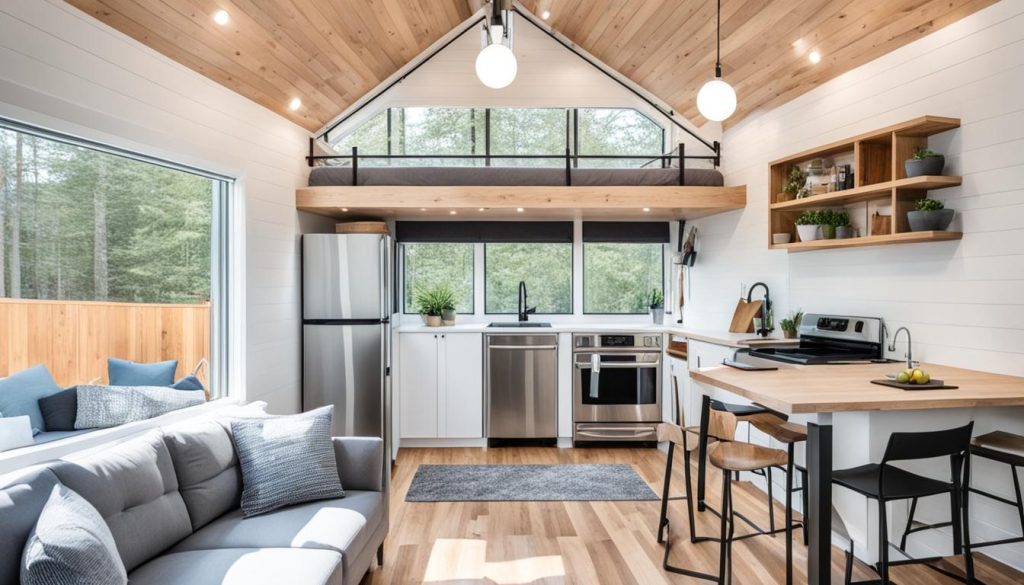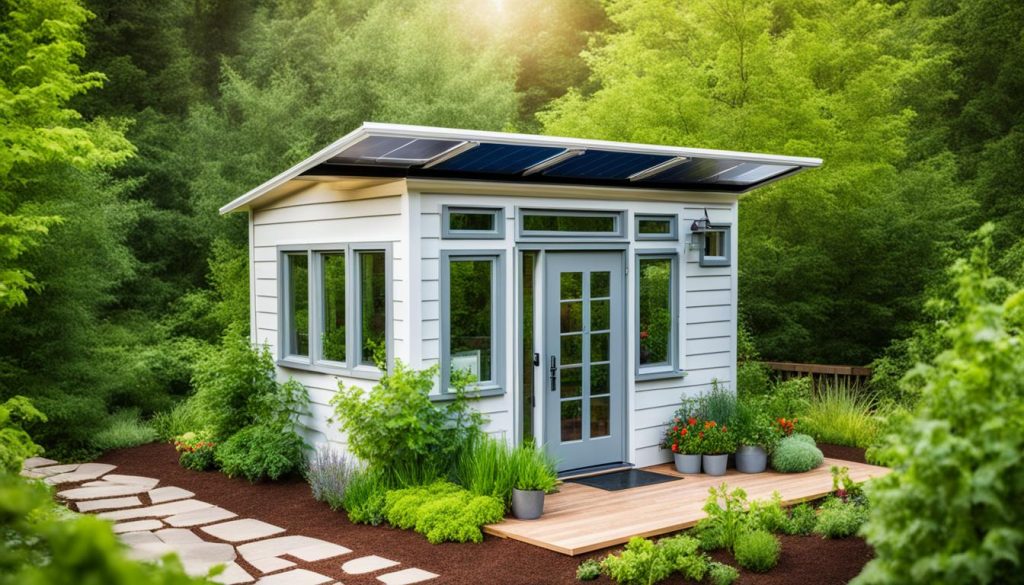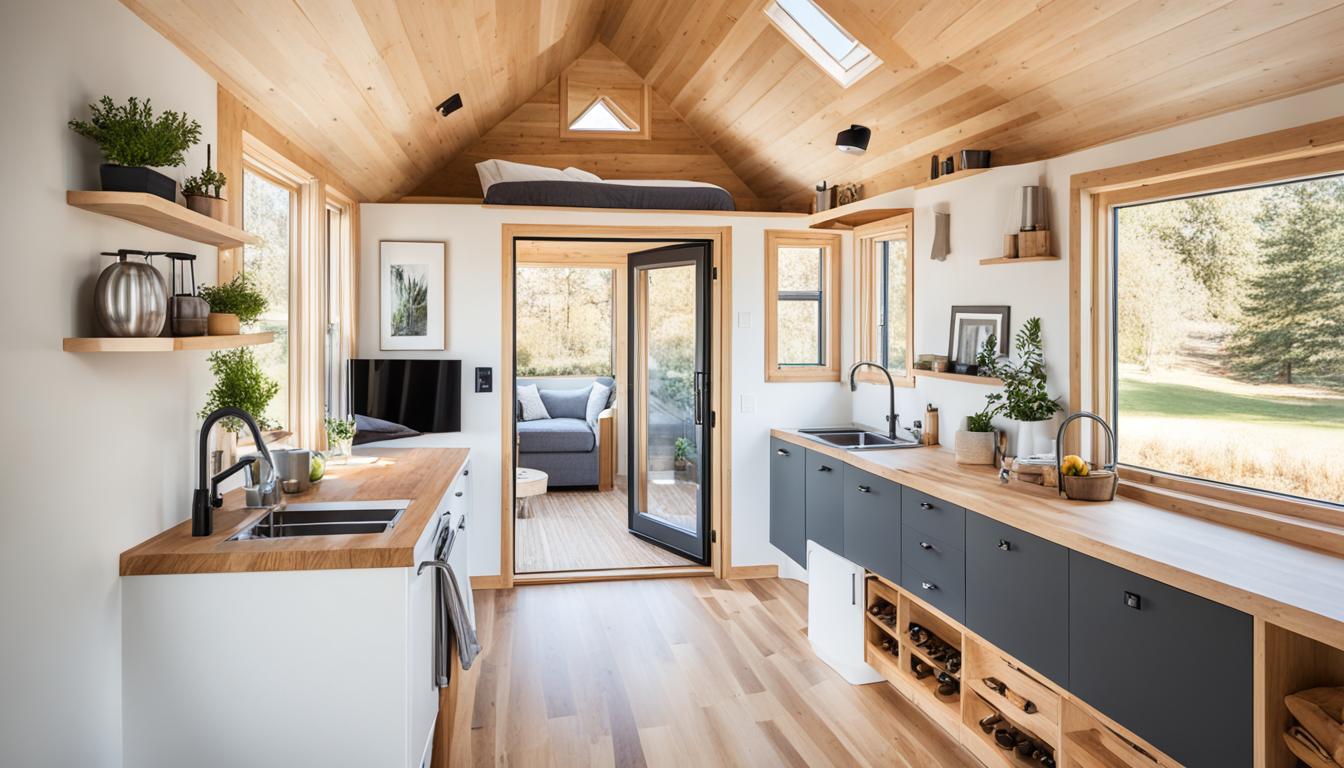Did you know that even within the realm of tiny houses, there are designs that prioritize spaciousness and luxury? Contrary to what you might expect, some tiny houses offer ample room and style, redefining the concept of compact living. These innovative designs prove that big living can be achieved within the smallest of spaces. Let’s dive into the world of the biggest tiny house designs and discover how they provide spacious living options for those seeking a minimalist and eco-friendly lifestyle.
Key Takeaways:
- Tiny house designs can offer spacious living options, challenging traditional notions of size and luxury.
- Open floor plans, abundant natural light, and clever storage solutions contribute to the sense of spaciousness.
- Spacious tiny houses promote a minimalist, eco-friendly lifestyle.
- These designs prioritize efficiency and functionality without compromising comfort.
- Embracing a minimalist lifestyle and reducing living expenses are some of the benefits of tiny house living.
The Benefits of Tiny House Living
Living in a tiny house offers a multitude of benefits that go beyond just saving space. It’s a lifestyle choice that promotes small living, embraces the tiny house movement, fosters a minimalist lifestyle, and encourages eco-friendly living.
One of the most significant advantages of tiny house living is the simplified lifestyle it offers. By downsizing and residing in a compact space, you can declutter your life and eliminate the burden of excessive possessions. Embracing minimalism allows you to focus on experiences and relationships instead of material belongings.
Moreover, tiny houses are inherently eco-friendly due to their reduced size and use of environmentally sustainable materials and systems. With minimized energy consumption for heating, cooling, and lighting, tiny homes help lower your carbon footprint and contribute to a cleaner environment. They also provide an excellent opportunity to incorporate eco-friendly practices like rainwater harvesting and solar panels.
Living in a tiny house can also positively impact your finances. By choosing a minimalist lifestyle, you can significantly reduce living expenses. Tiny homes are more affordable than traditional houses, resulting in lower mortgage payments, decreased utility bills, and minimal maintenance costs. This financial freedom allows you to save money, pay off debts, and achieve greater financial independence.
In summary, small living in a tiny house offers a myriad of benefits. It promotes a simplified lifestyle, relieves the burden of materialism, reduces living expenses, and fosters an eco-friendly way of living. By embracing the tiny house movement and adopting a minimalist mindset, you can experience the joys of a compact yet fulfilling life.
Efficient Design Principles of Tiny House Plans
Tiny house design is all about maximizing every inch of available space while ensuring comfort and functionality. These efficient design principles enable compact living without sacrificing essential amenities. Let’s explore some key strategies that make tiny house plans so efficient and livable.
- Creative Storage Solutions: Tiny houses utilize innovative storage options that capitalize on underutilized spaces. From built-in shelves and cabinets to hidden compartments, these storage solutions ensure that every item has its place, keeping the living area clutter-free and organized.
- Multi-functional Furniture: Compact living requires furniture that serves multiple purposes. Convertible sofas, folding tables, and built-in furniture with hidden storage compartments are common features in tiny house design. These versatile furniture pieces maximize functionality without taking up unnecessary space.
- Open Layouts: Open floor plans are a hallmark of tiny house design. By eliminating unnecessary walls and partitions, tiny houses create a sense of openness and spaciousness. This allows for better circulation and visual continuity, making the small space feel larger.
- Innovative Use of Vertical Space: Tiny house design often emphasizes vertical space utilization. Loft beds, suspended storage units, and high-mounted shelves make effective use of the vertical dimension, expanding storage capacity and creating visual interest.
By integrating these efficient design principles, tiny houses can provide a comfortable and functional living experience within a small footprint. The intelligent use of space ensures that every corner of the tiny house serves a purpose, making it an ideal solution for those seeking compact living without compromising on comfort.
The Allure of Spaciousness in Tiny House Designs
Despite their small size, many tiny house designs create an illusion of spaciousness. Open floor plans and abundant natural light contribute to a sense of airiness and fluidity. Multi-functional furniture and clever storage solutions optimize the use of space, making the interiors feel larger than they actually are. Additionally, incorporating outdoor living spaces like porches and decks extends the living area and further enhances the sense of spaciousness.
One of the key elements that make spacious tiny houses so appealing is their open floor plans. By eliminating unnecessary walls and barriers, the living areas flow seamlessly, creating a sense of continuity and freedom. This not only maximizes the usable space but also enhances the overall aesthetic appeal of the interior.
Natural light plays a crucial role in making tiny houses feel more spacious. Large windows, skylights, and strategically placed mirrors help to bring in ample sunlight, creating a bright and inviting atmosphere. The natural light reflects off the surfaces, giving the illusion of an expanded space and making the interior feel more open and airy.
Another design feature that contributes to the spacious feel of tiny houses is the use of multi-functional furniture. These innovative pieces serve multiple purposes, such as a sofa that converts into a bed or a dining table that can be folded down when not in use. By incorporating furniture that serves multiple functions, the living area can be optimized, creating more usable space for various activities.

Clever storage solutions are crucial in tiny house designs to keep the space organized and clutter-free. From built-in shelves and cabinets to hidden storage compartments under the stairs or bed, every nook and cranny is utilized efficiently. This allows for easy organization and storage of belongings, eliminating the need for additional furniture or external storage spaces.
Outdoor living spaces, such as porches, decks, and rooftop terraces, can significantly extend the available living area of a tiny house. By incorporating these outdoor spaces into the design, homeowners can enjoy additional space for relaxation, entertainment, or even gardening. Connecting the indoor and outdoor spaces seamlessly enhances the overall sense of spaciousness and offers opportunities for enjoying nature.
In conclusion, despite their compact size, many tiny house designs cleverly utilize various design principles to create a sense of spaciousness. Open floor plans, abundant natural light, multi-functional furniture, clever storage solutions, and incorporating outdoor living spaces all contribute to making the interiors of tiny houses feel much more spacious than one would expect. These design elements combine to offer a luxurious and comfortable living experience within a small footprint.
Environmental and Financial Benefits of Tiny House Living
Living in a tiny house brings about a range of environmental and financial advantages that are enticing for those seeking an eco-friendly and affordable lifestyle.
Reduced Energy Consumption
The smaller size of tiny houses leads to reduced energy consumption for heating, cooling, and lighting. The compact living space requires less energy to maintain comfortable temperatures and illuminate the interior, making it a more eco-friendly choice.
Eco-Friendly Materials and Systems
Many tiny house designs prioritize sustainability by incorporating eco-friendly materials and systems. Features such as solar panels and rainwater harvesting systems further reduce the environmental impact, allowing homeowners to embrace an eco-friendly living experience.
Affordable Housing
One of the most appealing aspects of tiny house living is its affordability. Tiny houses offer a more budget-friendly housing option compared to traditional homes. Reduced mortgage payments, lower utility bills, and minimal maintenance requirements contribute to a financial independence and a more cost-effective lifestyle.

The Minimalist Lifestyle
Tiny house living aligns closely with a minimalist lifestyle, promoting the idea of living with less and focusing on experiences rather than possessions. Embracing this lifestyle can lead to reduced expenses, less clutter, and a greater appreciation for the simple things in life.
Achieving Financial Independence
By reducing living expenses, tiny house living offers the opportunity to achieve financial independence. With lower mortgage payments, minimal utility bills, and less money spent on maintenance, individuals can redirect their resources towards other priorities, such as travel, hobbies, or savings.
Overall, tiny house living provides an environmentally conscious, budget-friendly, and minimalist lifestyle, making it an appealing housing choice for those seeking a more sustainable and affordable way of life.
The Freedom of Mobility in Tiny House Living
One of the most exciting aspects of the tiny house movement is the freedom of mobility it offers. Some tiny house designs incorporate wheels, allowing homeowners to embrace a truly mobile lifestyle. These portable tiny houses, commonly known as “tiny houses on trailers,” provide the perfect solution for those who crave adventure, exploration, and the ability to live in different locations without sacrificing the familiarity and coziness of their tiny house.
For individuals with a sense of wanderlust, tiny houses on trailers offer the freedom to easily pick up and relocate whenever the mood strikes. Whether it’s exploring new cities, immersing oneself in nature, or discovering hidden gems across the country, the mobility aspect of tiny house living opens up a world of possibilities.
Imagine waking up to breathtaking views of the mountains one week, and then enjoying the tranquility of a lakeside retreat the next. With a mobile tiny house, you can chase the perfect weather, follow your passions, or simply satisfy your curiosity about different regions and communities.
Not only does mobile tiny house living provide the opportunity for adventure, but it also allows individuals to embrace a truly compact and minimalist lifestyle. By downsizing and living in a small space, homeowners can focus on what truly matters to them. Whether it’s pursuing a passion, spending quality time with loved ones, or engaging in outdoor activities, a mobile tiny house enables a more intentional and fulfilling way of living.
Furthermore, mobile tiny houses present a unique solution for those seeking affordable housing options. As housing prices continue to rise, many individuals are searching for alternatives that offer financial freedom without sacrificing comfort. The affordability and versatility of mobile tiny houses make them an attractive choice for individuals looking to escape the burden of excessive mortgages and high living expenses.
With the tiny house movement gaining momentum, the freedom of mobility has become an integral aspect of this unique lifestyle. Mobile tiny houses provide the perfect blend of compact living, adventure, and affordability, allowing individuals to embrace a truly mobile lifestyle while still enjoying the comforts of home. Whether they are exploring new horizons or simply seeking a more sustainable way of living, the mobility aspect of tiny house living offers endless possibilities and a newfound sense of freedom.
Design Strategies for Comfort and Functionality in Tiny Houses
When it comes to tiny house living, comfort and functionality are paramount. Despite their small size, tiny houses are designed to optimize every inch of space, ensuring a comfortable and enjoyable living experience. Let’s explore some design strategies that make tiny houses a haven of comfort and functionality.
Open Floor Plans for a Sense of Spaciousness
One of the key design elements in tiny houses is the use of open floor plans. By eliminating unnecessary walls and barriers, an open layout creates a sense of spaciousness and flow. The absence of divisions allows for flexibility in arranging furniture and creates an inviting atmosphere for both residents and guests.
Multi-functional Furniture for Versatility
Another ingenious design strategy in tiny houses is the use of multi-functional furniture. These pieces serve multiple purposes, maximizing the functionality of a small space. From convertible sofas and folding tables to storage ottomans and wall beds, multi-functional furniture allows for versatility in how the space is utilized. With just a few adjustments, a living room can be transformed into a bedroom or a dining area, making every square foot count.
Clever Storage Solutions for Optimal Organization
In tiny houses, every inch of space is precious, which is why clever storage solutions are essential. Built-in shelves, cabinets, and drawers optimize vertical and horizontal space, ensuring that belongings are neatly organized and easily accessible. From utilizing under-stairs storage to incorporating hidden compartments in furniture, these design elements make the most of limited storage options and minimize clutter.
Abundant Natural Light and Outdoor Connection
Natural light plays a crucial role in creating a comfortable and inviting atmosphere in tiny houses. Large windows and skylights bring in ample sunlight, making the interior feel bright and airy. Additionally, designing tiny houses with a strong connection to the outdoors helps expand the living space. Outdoor living areas, such as porches or decks, provide an extension of the indoor space, allowing residents to enjoy nature and relax outside their compact dwelling.
By employing these design strategies, tiny houses can offer both comfort and functionality within their compact footprint. Open floor plans, multi-functional furniture, clever storage solutions, and a strong connection to the outdoors all contribute to a comfortable and enjoyable living experience. Despite their size, these small homes are a testament to the ingenuity of design and the limitless possibilities of living big in a tiny space.
Tiny House Living as a Lifestyle Choice
Tiny house living is more than just a housing choice – it’s a way of life that embraces minimalism, eco-friendly living, and the allure of a unique dwelling. For those seeking to downsize and simplify their lives, tiny house living offers the opportunity to prioritize experiences, relationships, and personal growth. By redefining what it means to live large, tiny house plans allow individuals to achieve financial independence while reducing their environmental footprint.
Living in a tiny house encourages a minimalist lifestyle, where possessions are curated with intention and excessive consumerism is left behind. Embracing simplicity not only declutters physical space but also frees up mental and emotional energy, allowing for a greater focus on what truly matters. With less time and money spent on maintaining a large home, individuals can redirect their resources towards experiences, self-discovery, and pursuing their passions.
Eco-friendly living is another pillar of the tiny house movement. With their smaller size, tiny houses require fewer resources to build and maintain, resulting in a smaller carbon footprint. Many tiny house designs incorporate sustainable materials and energy-efficient systems, such as solar power and rainwater harvesting, further reducing environmental impact. By choosing a tiny house as their unique dwelling, individuals are actively contributing to a more sustainable future.
In conclusion, tiny house living is a lifestyle choice that challenges conventional notions of what it means to have a home. It offers an opportunity to live intentionally, prioritize experiences over possessions, and make a positive impact on the planet. By embracing a minimalist ethos and choosing an eco-friendly dwelling, individuals can create a fulfilling and unique way of life within the compact confines of a tiny house.

Leave a Reply
You must be logged in to post a comment.